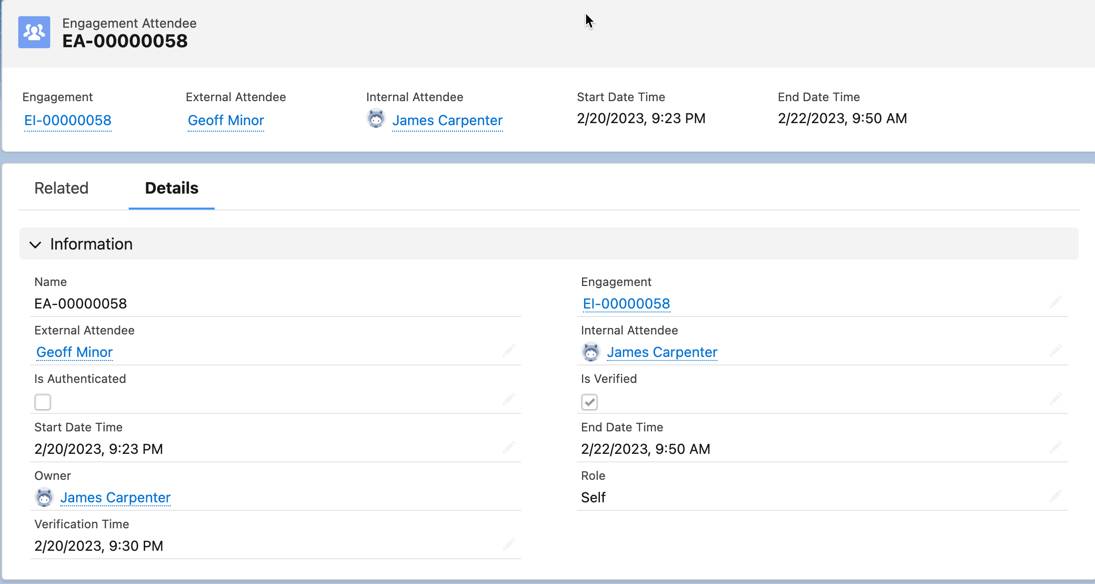製造業のサービス向けに組織を準備する
学習の目的
この単元を完了すると、次のことができるようになります。
- 一般的なサービスエクスペリエンスのフェーズで、製造のサービスコンソールがどのように役立つか説明する。
- コンピューターテレフォニーインテグレーション (CTI) のイネーブルメントの主な手順を概説する。
- エンゲージメントデータモデルの主なオブジェクトについて説明する。
- ID 検証のレコードとフローを確認する。
サービスエージェントのフェーズを確認する
Cindy は設定手順に進む前に、製造のサービスコンソールを使用した一般的なサービスワークフローがどのようなものか理解したいと考えます。

サービスワークフローが次の 7 つのフェーズで構成されることがわかりました。
開始
コールセンターのエージェントとお客様またはパートナー間の各コミュニケーションレコードをインタラクションといいます。パートナーまたはお客様は、音声通話、メール、メッセージ、ビデオ通話など任意のチャネルでインタラクションを開始できます。インタラクションで複数のトピックが取り上げられることがあります。
認証
大半のインタラクションは、コンタクトセンターに電話がかかってきたときに始まります。Salesforce でコンピューターテレフォニーインテグレーション (CTI) を使用している場合は、着信した電話番号に関連付けられているすべてのデータが自動的に画面にポップアップ表示されます。必要なインテグレーションが設定されている場合は、パートナーまたはお客様から電話を受けるたびに、バックグラウンドでエンゲージメントインタラクションレコードが自動的に作成されます。
検証
エージェントは通常、登録ユーザーだけでなく、登録されていない通話者からの電話にも応答します。こうした人々は、システムに詳細情報がありません。
通信者がどちらの場合でも、Manufacturing Cloud に事前定義された [Identity Verification (ID 検証)] フローが役立ちます。未登録のユーザーについては、エージェントが最初に名前、電話番号、その他の条件で検索できます。続いて、サービスエージェントは登録ユーザーと未登録ユーザーのどちらに対しても、基本的な詳細を確認して通信者の本人確認を行い、不正行為を回避して信頼を維持します。本人確認を行うと、通話の理由、出席者の名前、その他の詳細でエンゲージメントインタラクションレコードが更新されます。
コンテキストの把握
通話者の ID 検証に問題がなければ、コンソールでエージェントが自動的に通話者の取引先責任者ページにリダイレクトされます。このページは Manufacturing Cloud for Service 向けに改装されています。このページのタイムラインコンポーネントにある時系列ビューに、過去、現在、今後のすべてのインタラクションが表示されます。エージェントは [Cases (ケース)]、[Orders (注文)]、[Assets (納入商品)] 関連リストですべての関連レコードをすばやく確認できるため、コンテキストに応じた会話を進めることができます。
トランザクション
サービスエージェントはインタラクション中に、[Actions & Recommendations (アクション & おすすめ)] コンポーネントの [Actions (アクション)] タブを使用して、サービス予定の作成、メモの作成、ケースの登録など、頻繁に実行するアクションをコンソール内から起動できます。
コンソールにアクションランチャーコンポーネントが設定されている場合は、エージェントが他の Omnistudio やフローベースのアクションもトリガーできます。さらに、サービスエージェントはナレッジコンポーネントを使用して、通話者の照会に有意義な回答をすることができます。
アウトリーチ
サービスエージェントは、レコードアラートコンポーネントに表示される重大な警告、更新、その他のレコードアラートに関する情報を通話者にプロアクティブに伝えることができます。
また、システム管理者が設定したインテリジェントなおすすめや次善アクションも確認できます。こうした情報は [Actions & Recommendations (アクション & おすすめ)] コンポーネントの [Recommendations (おすすめ)] タブに表示されます。
コネクテッドコミュニケーション
インタラクションが完了すると、エンゲージメントインタラクションレコードが自動的に更新され、検証の詳細が表示されます。また、関連するトピックや出席者のレコードも更新されます。このため、情報が失われる可能性がほぼなく、信頼できる情報源が共有されます。次に電話がかかってきたときに、サービスエージェントは以前のすべてのインタラクションにアクセスできるため、その情報を踏まえて対応できます。また、監査履歴を使用してレコードを見つけることも可能です。
Salesforce コールセンター
ほぼすべてのサービスコミュニケーションが電話から始まることを Cindy は心得ています。大半のコミュニケーションは電話かビデオ通話で行われるため、CTI インテグレーションを設定することが重要です。ID 検証フローとエンゲージメントデータモデルは、Service Cloud の CTI プロセスとシームレスに連携します。
ソフトフォンを設定して、ダウンストリームのサービスプロセスに接続する主な手順は、次のとおりです。
- AppExchange から CTI パッケージをインストールします。Salesforce と統合した Open CTI システムで、Rayler Parts のコールセンターが構成されます。
- インストールしたパッケージに付属する CTI 定義ファイルを編集します。この定義ファイルは、項目、項目順序、使用する API、ソフトフォンの高さと幅など、コールセンターのプロパティを定義するのに役立ちます。
![[Setup (設定)] で定義されたソフトフォンのプロパティ](https://res.cloudinary.com/hy4kyit2a/f_auto,fl_lossy,q_70/learn/modules/service-console-for-manufacturing-cloud-admin-essentials/prepare-your-org-for-manufacturing-service/images/ja-JP/ba031e43fd18987d54ae10e54ed09150_77-e-6-ccc-3-43-dc-4619-a-6-cc-3-bbef-9830196.png)
- 更新した定義ファイルを Salesforce 組織にインポートし、[Setup (設定)] でコールセンターを作成します。
![[Setup (設定)] の [Call Center (コールセンター)] の詳細](https://res.cloudinary.com/hy4kyit2a/f_auto,fl_lossy,q_70/learn/modules/service-console-for-manufacturing-cloud-admin-essentials/prepare-your-org-for-manufacturing-service/images/ja-JP/10544e073e33ba5c6dabb1260c98533f_25-ca-477-e-c-182-4-dbd-bfc-8-73-f-441533-d-84.png)
- コールセンターにユーザーを追加して、ソフトフォンを使用できるユーザーを決定します。また、検索条件を指定して、コールセンターに割り当てるエージェントを見つけることもできます。
![[Setup (設定)] のソフトフォンレコードに関連するユーザープロファイル](https://res.cloudinary.com/hy4kyit2a/f_auto,fl_lossy,q_70/learn/modules/service-console-for-manufacturing-cloud-admin-essentials/prepare-your-org-for-manufacturing-service/images/ja-JP/388c6c4d12bf77837afafc6d5b7f9448_41309-a-94-5-c-7-c-43-ff-b-1-aa-dd-47073-fdbb-1.png)
- サービスコンソールアプリケーションのユーティリティバーにソフトフォンを追加して、コンソールのフッターから簡単にアクセスできるようにします。
![製造のサービスコンソールアプリケーションに追加された [Open CTI Softphone (Open CTI ソフトフォン)] ユーティリティ項目](https://res.cloudinary.com/hy4kyit2a/f_auto,fl_lossy,q_70/learn/modules/service-console-for-manufacturing-cloud-admin-essentials/prepare-your-org-for-manufacturing-service/images/ja-JP/3cde31f4ba93dd3361a5583f52182485_a-5612472-3-aaa-409-a-b-19-d-53-c-7-a-632-e-59-e.png)
- コンソールアプリケーションを、アクセスする必要があるすべてのユーザープロファイルに割り当てます。
- Engagement Connect API を使用して、ソフトフォンとエンゲージメントインタラクションレコード間のリンクを設定します。電話がかかってきたときに、エンゲージメントインタラクションレコードが自動的に作成されるようになります。
CTI インテグレーションの詳しい手順については、「Lightning Experience のコールセンターインテグレーション」モジュールと「Salesforce Open CTI」トピックを参照してください。
Cindy は、パートナーテレフォニー用の Service Cloud Voice (BYOT) でも、同様のエクスペリエンスになるように設定できることを知りました。詳細は、「パートナーテレフォニーを使用する Service Cloud Voice の設定」を参照してください。
エンゲージメントデータモデル
サービスコミュニケーションの重要な詳細を取得するためには、ケースレコードよりエンゲージメントインタラクションレコードのほうが適していることがわかりました。1 件のエンゲージメントインタラクションレコードを複数の出席者と複数のエンゲージメントトピックに関連付けられる一方で、ケースは常に 1 回のみの使用と 2 人の出席者に限定されます。
Cindy は特に 3 つのオブジェクトと、そこにどのような情報が保存されるのかが気になります。そこで、データモデル情報を確認します。

エンゲージメントインタラクションオブジェクトは、サービス担当や組織の他のスペシャリストと、組織のお客様やパートナーの間のインタラクションに関する情報を表します。主な詳細が入力されているエンゲージメントインタラクションレコードのサンプルを見てみましょう。

| 項目 | 値 |
|---|---|
|
Communication Channel (コミュニケーションチャネル) |
Voice Call (音声通話) |
|
Duration (通話時間) |
10 minutes (10 分) |
|
Status (状況) |
In Progress (進行中) |
|
Sentiment (センチメント) |
Positive (肯定的) |
|
Reason (理由) |
|
|
Type (種別) |
Inbound (着信) |
|
Context (コンテキスト) |
Compactor 8000 のサービス予定 |
|
Verification Time (検証時刻) |
|
|
Attendee Verified? (出席者検証済み) |
Yes (はい) |
エンゲージメント出席者オブジェクトは、電話をかけてきたパートナーやサポートエージェントなど、インタラクションに関与する人々に関する情報を表します。主な詳細が入力されているエンゲージメント出席者レコードのサンプルを見てみましょう。

| 項目 | 値 |
|---|---|
|
Role (ロール) |
Self (本人) |
|
Internal Attendee (内部出席者) |
エージェントのユーザーレコード |
|
External Attendee (外部出席者) |
パートナーの取引先責任者レコード |
|
Verification Time (検証時刻) |
9:50 AM |
|
Attendee Verified? (出席者検証済み) |
Yes (はい) |
エンゲージメントトピックオブジェクトは、インタラクション中に話し合われたすべての問題または会話の要点に関する情報を表します。主な詳細が入力されているエンゲージメントトピックレコードのサンプルを見てみましょう。

| 項目 | 値 |
|---|---|
|
Topic (トピック) |
注文 |
|
Process Type (プロセス種別) |
Omniscript |
|
Interaction Summary (インタラクション概要) |
Placed a new order for two products. (新たに 2 つの商品を発注) |
|
Related To (関連先) |
通話者であるパートナーの取引先責任者 |
|
Process Status (プロセス状況) |
Completed (完了) |
続いて、Cindy は ID 検証フローに進みます。Manufacturing for Service にどのようなものが付属するのかに関心があります。
Manufacturing Cloud の ID 検証
組織で製造のサービスコンソールを有効にすると、組織に数種の ID 検証レコードとともに、Salesforce フローテンプレートが自動的に作成されます。Cindy はこのレコードとフローに着目します。
[Setup (設定)] の [Identity Verification Process Definition (ID 検証プロセス定義)] ページに移動して、[Sample Verification Flow for Manufacturing Service (製造サービスのサンプル検証フロー)] というレコードを確認します。このレコードには、Manufacturing Cloud のサービスコンソールで ID 検証プロセスがどのように動作するかを決定するメタデータが保持されています。![Manufacturing Cloud に事前定義されている [Identity Verification Process Definition (ID 検証プロセス定義)] レコード](https://res.cloudinary.com/hy4kyit2a/f_auto,fl_lossy,q_70/learn/modules/service-console-for-manufacturing-cloud-admin-essentials/prepare-your-org-for-manufacturing-service/images/ja-JP/69ad9e681227addcb97d0122b1b6d144_0-be-4-c-95-d-f-720-4-e-03-8-b-36-c-850-f-6-d-4-fe-70.png)
続いて、[Setup (設定)] の [Identity Verification Process Details (ID 検証プロセスの詳細)] ページに移動して、ContactSearch レコードを確認します。このレコードがあれば、エージェントが対応する取引先責任者レコードの詳細に基づいて、通話者の詳細を検証できます。![Manufacturing Cloud に事前定義されている [Identity Verification Process Details (ID 検証プロセスの詳細)] レコード](https://res.cloudinary.com/hy4kyit2a/f_auto,fl_lossy,q_70/learn/modules/service-console-for-manufacturing-cloud-admin-essentials/prepare-your-org-for-manufacturing-service/images/ja-JP/1fe20a86a9d5ffb69222ae2609964a69_acd-169-ed-9213-46-ca-86-cf-389876-e-604-dd.png)
Cindy は [Setup (設定)] の [Identity Verification Process Field (ID 検証プロセス項目)] ページに移動して、ContactSearch プロセス詳細レコードに関連する次のレコードを確認します。
| 項目名 | 項目種別 | 詳細 |
|---|---|---|
|
PhoneSearchEmailSearch |
検索項目 |
未登録の通話者から電話がかかってきたときに、ソフトフォンにその通話者の詳細が表示されない場合は、エージェントが通話者の電話番号またはメールアドレスで検索できます。 |
|
ContactNameResultAccount NameResult |
結果項目 |
エージェントが通話者を検索すると、検索結果に検索条件と一致するすべての取引先責任者レコードと取引先レコードが表示されます。 |
|
ContactNameAccountName |
必須のベリファイアー |
通話者が述べた本人の名前と関連取引先の情報が、ID 検証画面でエージェントに表示される詳細と一致している必要があります。 |
|
PhoneEmail |
省略可能なベリファイアー |
エージェントは検証を徹底する目的で、通話者にさらに電話番号とメールアドレスを述べてもらうことができます。 |
![Manufacturing Cloud に事前定義されている [Identity Verification Process Field (ID 検証プロセス項目)] レコード](https://res.cloudinary.com/hy4kyit2a/f_auto,fl_lossy,q_70/learn/modules/service-console-for-manufacturing-cloud-admin-essentials/prepare-your-org-for-manufacturing-service/images/ja-JP/3e0d319328940dbe012db809bb1a2a50_dd-59798-b-28-da-418-f-9039-fc-6-e-4-de-440-c-4.png)
Cindy は [Setup (設定)] の [Identity Verification Settings (ID 検証設定)] ページにあるガイド付き設定を使用して、Manufacturing Cloud に付属する事前定義されたレコードをいつでも編集できます。たとえば、住所も省略可能なベリファイアー項目に追加する場合、簡単に設定できます。
Manufacturing Cloud にはまた、通話者 ID 検証プロセスを設計する [Verify Caller Identity (通話者 ID を検証)] というフローテンプレートが事前定義されています。Cindy は必要に応じてこのテンプレートをカスタマイズできます。ただし、検証フローを自分で設計する必要はありません。Manufacturing Cloud に任せます。![Manufacturing Cloud に事前定義されている [Verify Caller Identity (通話者 ID を検証)] フロー](https://res.cloudinary.com/hy4kyit2a/f_auto,fl_lossy,q_70/learn/modules/service-console-for-manufacturing-cloud-admin-essentials/prepare-your-org-for-manufacturing-service/images/ja-JP/f6673f61ad320953532459e33dab57ef_949-f-8-a-53-bc-1-b-48-af-a-41-a-41-eb-76360963.png)
カスタマイズの要望を理解する
Cindy は Najma とのミーティングで、現時点の実装の進捗状況について協議します。次の単元では、Cindy がナレッジ、タイムライン、レコードアラートなどの各機能の設定を確認するところを見ていきます。
その前に、Najma が Cindy にカスタマイズしてもらいたい点を書き出しました。Najma はチームのエージェントの生産性を高めるために、Cindy に次のようなカスタム設定を試してもらいたいと考えています。
- 取引先レコードに、訪問、商談、リベート請求の時系列リストを示すタイムラインを表示したい。
- 検証質問を追加して、エージェントが通話の理由で「支払の照会」を選べるようにしたい。
- コンソールに、パートナーに関連する販売合意、リベートメンバー、作業指示を表示したい。
Cindy は、この先どうなっていくのかワクワクしています!